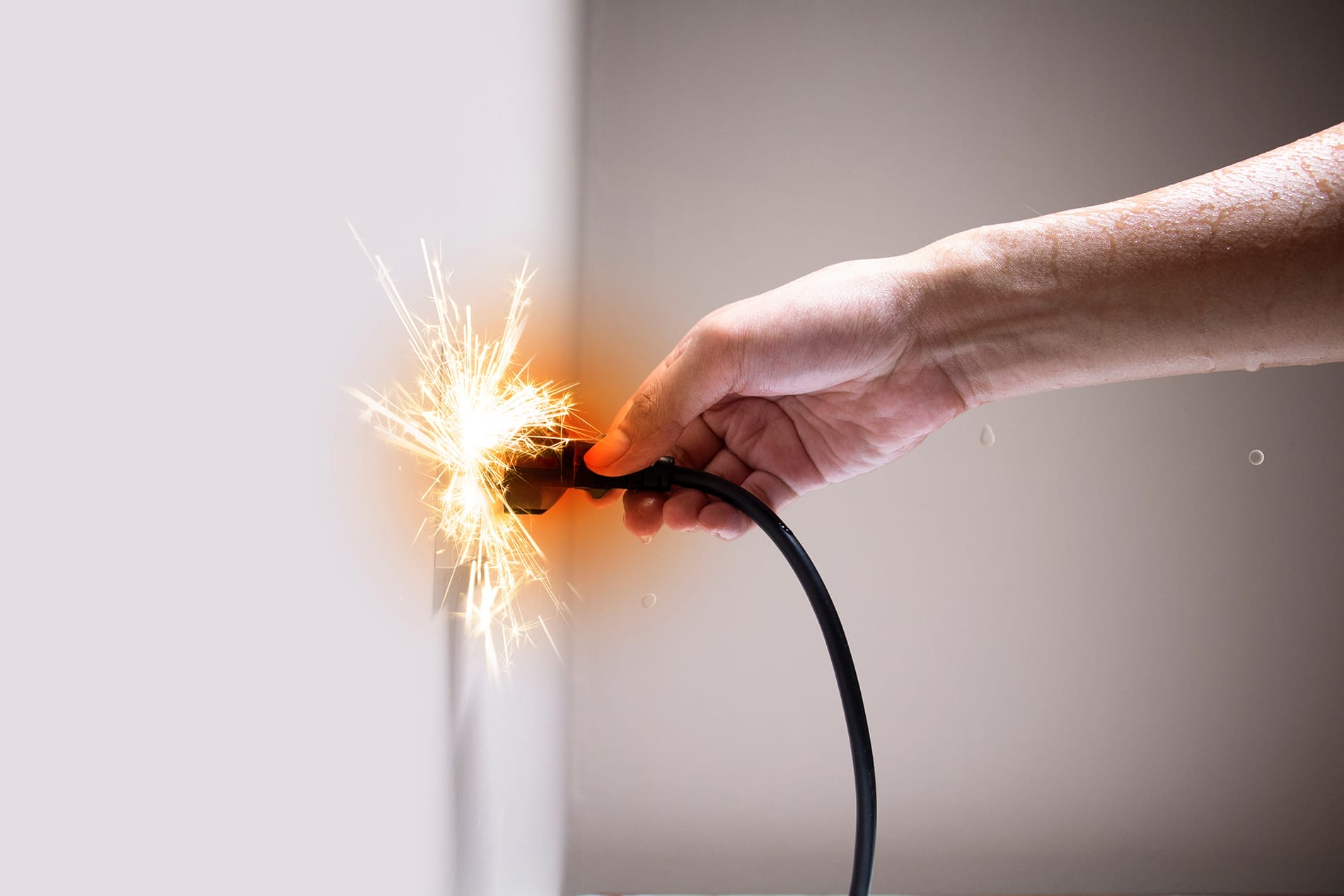An electric shock can range from a short, sharp sensation to life-threatening and death-provoking charges.
People’s experience of electric shocks depends on the electrical current’s strength and contact duration. Indeed, electric shocks are even part of “fun” games you can buy — the Lightning Reaction Reloaded quick reactions game delivers a small electric shock to the losing player.
Electricity is both dangerous and valuable to humans. Here, we’ll explore the world of electric shock, from electrical injuries and first aid treatment to preventing electrical shock in the first place.
What Is Electric Shock, and How Does It Occur?
An electric shock occurs when the human body comes into contact with electricity. The electric current from the electricity means an electric current flows through the human body.
Our nervous system uses electricity within our bodies to send signals to our brain and internal organs. Electric currents pass easily through our bodies because our living tissues contain a lot of water, which is a good conductor of electricity.
Electric shocks occur when any part of the body comes into contact with an external source of electricity. These electrical sources could be a lightning strike or a downed power line.
What Does an Electric Shock Feel Like?
Electricity that has entered the body is trying to find its way out, often through the ground. The damage caused to a person by an electric shock depends on the strength and type of current, how long contact with the current lasts, and where it enters and exits the body.
A mild electrical shock could bring a tingling sensation or cause a little pain. Sometimes, a strong shock for a short duration, like a static shock from a car, can mean up to 10,000 volts passing through our bodies.
Electrical injuries happen when strong currents last for more extended periods. This could result in excruciating pain, muscle spasms, and loss of consciousness. Some people remember nothing of the electric shock but feel like they’ve been in a road traffic accident. Others have electrical burns, where the electricity enters and exits the body.
What Affects the Severity of an Electric Shock?
The severity of an electric shock depends on several factors:
- The source of electricity: High-voltage shocks are those above 1,000 volts, while low-voltage shocks are below that.
- The type of current: Direct current (DC) is more likely to cause a muscle spasm than Nikola Tesla’s alternating current (AC). Muscle spasms, called tetany, mean a person cannot let go of the source of electricity, prolonging and worsening the shock.
- Electric current contact direction and time: Longer contact time with a source of electricity means more electrical energy entering the human body, increasing potential damage. Also, any current that enters the body and crosses past the heart is more likely to cause more significant damage to the heart.
Amps or Current: What’s the Danger With Electric Shocks?
Current is measured in amperes or amps. A high current that triggers muscle spasms would be anything from 15-20 amperes or higher. The amperage has the most significant influence on someone surviving an electric shock.
For example, a lightning bolt offers a short but potentially deadly blast of 300 million volts and 30,000 amps. People can survive lightning strikes because contact time is so short. In contrast, a typical U.S. building’s electricity power supply runs on 120 volts and 15 amps. Still, it can easily be deadly if held for long enough.
A mild shock can come from as few as 50 volts. Static electricity shocks, such as those we experience when getting out of cars, can be as high as 10,000 volts. These static shocks don’t cause lasting damage because they endure for such short periods.
However, never be complacent around electrical equipment. The Merck Manual states low-frequency alternating currents can be more harmful than direct currents because muscle contraction “may freeze the hand to the current’s source and prolong exposure.”
Enter your ZIP Code and compare electricity rates
What Are the Electrical Injuries Associated With Electric Shock?
Electric shock injuries may lead to mild or severe injury. These can include the following:
- Breathing difficulties
- Loss of consciousness
- Muscle contractions and spasms that prevent people from letting go of the source of electricity, increasing the shock levels
- Electrical burns, with severe burns at the electrical current’s entry and exit points
- Cataracts
- Internal injuries caused by the electrical current heating internal organs or tissue damage to the skin, muscles, or ligaments
- Cardiac arrest
Injuries can be life-changing, with amputations of damaged body parts not uncommon from severe electric shocks. Cardiac arrest may occur if the electric current reaches the heart, causing arrhythmias and ventricular fibrillation (VF), which disrupt the heart’s rhythm.
In the workplace in the United States, there are more than 300 deaths and 4,000 injuries from electrical hazards annually. Nationwide, every year, there are more than 24,000 electrical fires and almost 300 deaths caused by electrical fires in residential properties. Animals are also more sensitive to electric shocks than people.
Aside from death, lightning injuries include memory loss, change of personality, hearing problems, plus all of the above.
What Are the First Aid Procedures for Someone Who Has Experienced an Electric Shock?
Your first step is to protect yourself and the person experiencing an electric shock.
Electric shock victims may still be in contact with the electrical devices or power supply causing them the electrical shock. For that reason, you should never touch someone suffering an electrical shock. Doing so will make you part of the electrical circuit, and you, too, will get an electric shock and risk electrocution.
Here’s what to do instead:
- Switch off the electricity at the mains, unplug all electrical cords and devices, and remove fuses.
- Stay well clear of any downed power lines.
- If you cannot turn off the electricity, use a non-conductive material like a wooden broom to move the victim away from electrical sources. Stand on non-conductive materials like newspapers or rubber matting. Ensure the shock victim is not touching or in contact with water.
You can now start First Aid. Remember to call for help once you have made the area safe.
- Response: Are they conscious? Ask them their name, check their hearing, and pinch them if you can’t get a response. Once responsive, call the emergency department or the relevant healthcare cover for medical attention — the victim may have internal damage you can’t see.
- Unresponsive: Ensure the victim is breathing; open their airways by tilting their head back. Check for and remove any obstructions. Put them in the recovery position and call the emergency department.
- Unresponsive and not breathing normally: Qualified first aiders can give cardiopulmonary resuscitation (CPR) until help arrives if required. Read about how to give CPR. There may be defibrillators nearby, too.
- Burns: Cool any burns with running cold water or wet dressings once the person is in the recovery position.
- Seizures: Time any seizures and try to prevent further injuries by catching anyone who falls.
Severe electric shock victims will have their hearts monitored with electrocardiograms (ECG) once at the hospital. All pregnant women who suffer an electric shock should get checked by their doctor.
Following an electric shock, anyone who later is confused, has a seizure, breathing difficulties, tingling sensations, paralysis, hearing, vision, or speech problems should contact their doctor immediately.
Why Does a Person Die of Electric Shock?
Electric shock usually causes death by disrupting or completely stopping the heartbeat’s regular rhythm.
Several electrical burns, internal damage to organs, and other injuries could all contribute to someone’s death from electric shock.
In the United States, prisoners may still be executed using electricity. Eight states permit death by electrocution for offenders. In South Carolina, it’s the primary execution method.
What Safety Measures and Precautions Can Individuals Take to Prevent Electric Shock?
Installing a circuit breaker is not a one-stop shop for preventing electric shocks. Circuit breakers may eventually trip the fuses and stop the electrical current. Still, the damage to someone may have already been done by then. That’s because circuit breakers don’t kick in immediately.
There are some basic rules to follow to reduce the risk of electric shocks, valid for home and the workplace. These include:
- Install child safety protectors on all electrical outlets.
- Never use damaged or defective extension cords, electrical devices, or electrical outlets.
- Don’t pull an electrical device’s cord to unplug it — instead, pull the plug from the electrical outlet to avoid damaging the device’s electrical workings.
- Unplug any device before fixing or altering it. This includes trying to fish toast from the toaster, changing a light bulb, and filling an iron with water.
- Always know the location of your building’s electrical wires before drilling holes in walls.
- Water and electricity don’t mix. Never use electrical appliances in bathrooms. Don’t utilize cords or devices near swimming pools. Never touch anything electrical while your hands are wet.
- Don’t overload multi-plug outlets with devices that require more than the outlet can support.
Clothing can also help protect people from electric shocks. Wear nylon, rubber, or non-conductive gloves, helmets, and shoes. Footwear is especially important in workplaces with a high risk of electrical shock through grounding.
In contrast, some industries, like electronics manufacturing, may require people to wear conductive footwear to avoid potential static shocks. There are also specialized tools to protect people from electric shocks, from screwdrivers to pliers to safety glasses.
What Are the Common Causes of Electric Shock Incidents in Industrial Settings?
The most common electric shock hazards in the workplace include the wear and tear of electrical appliances not giving sufficient protection and damaged devices not working correctly. Daisy chaining extension cords, circuit breaker failures, and general inadequate maintenance all contribute to electric shocks.
Many electric shocks come from workers in direct contact with power lines, machines, or tools.
What Are the Common Causes of Electric Shock Incidents at Home?
People at home are similarly likely to receive an electric shock from poorly maintained electrical devices, overloaded extension cords, and general wear and tear of electrical appliances.
Wet bathroom conditions, poor or damaged wiring, dodgy electrical DIY, improper grounding, and kids fiddling with electrical outlets are other common causes of electrical shocks.
What Role Do Electrical Grounding and Insulation Play in Preventing Electric Shock?
Grounding and insulation are vital tools in preventing electric shock. Grounding allows excess electricity surges, usually provoked by faults, to discharge harmlessly into the ground rather than dangerously through a building’s electrical circuit. This protects people, helps prevent fires, and avoids damage to electrical equipment. Qualified electricians should be employed to install grounding for all buildings.
Insulation is something we’re more familiar with on a daily basis. Plugs and electrical appliances are covered with non-conductive materials like ceramic, plastic, and fiberglass. These materials shield us from an electrical device’s electricity-carrying components, like wires.
Knowledge is Power: Understand the Hazards of Electric Shock
From a rapid static shock to the power of a lightning shock, electrical shocks are more common than we may think. Most pass off without serious injury, but it’s prudent always to take great care around electricity.
Electric shocks happen in milliseconds. Possible muscle spasms mean you may not be able to let go of its source, so the shock can quickly escalate into a life-threatening and deadly episode.
Never play with electricity — get professional, accredited electricians for electrical work, and ensure wires, appliances, and outlets are in good working order. There will be more electric cars, more electrical gadgets at home, and more power lines overhead, meaning more potential contact points for an electric shock.
A healthy respect for electricity’s power will be even more critical as the world transitions to a more electricity-based society to cut emissions and limit climate change.
Brought to you by energysavings.com
All images licensed from Adobe Stock.




